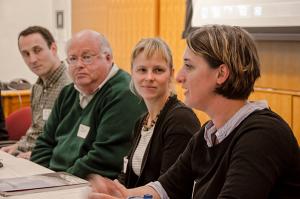This new video shows how Oregon Sea Grant’s Summer Scholars program helps prepare high-caliber junior and senior undergraduates from around the U.S. for careers in the marine sciences or the management of coastal resources. The program places students with Oregon-based federal and state agencies and nongovernmental organizations for paid, 10-week internships.
Students are assigned to a specific project under a mentor. They may assist their mentors with field work, lab work, analysis, research, policy development or public engagement efforts.
The video, produced by Oregon Sea Grant (OSG), also highlights some of this summer’s activities and includes interviews with students and mentors.
Ten students from seven different states participated in this year’s program, interning with agencies such as the Oregon Department of Fish and Wildlife (ODFW), the USDA, the OSU Extension Tourism Program, the EPA and the South Slough National Estuarine Research Reserve. Students worked on topics ranging from monitoring recovering sea star populations to spreading awareness about marine reserves to testing unmanned aircraft systems’ viability in shellfish surveys.
Students also participated in a professional-development workshop on science communication and outreach and engagement. The workshop was followed by a hiking and camping trip, allowing students both to explore more of Oregon’s scenic beauty and spend some quality time with their cohort.
The program culminated with a symposium that was open to the public. Friends, family, mentors and coworkers came to watch the scholars present on their summer’s work.
“The skills I’ve gained this summer as a scholar seem a little difficult to quantify because it feels like there’s a lot,” student Catie Michel said in the video. “But I’ve especially appreciated learning about successful collaboration with people and effective communication, especially in terms of science and research.”
In addition to aligning with OSG’s vision, mission and values, the goals of the Summer Scholars program are to
- prepare students for graduate school and/or careers in marine science, policy, management, and outreach through funding support and hands-on experience;
- support host organization program initiatives and facilitate scholars’ understanding of their work’s importance in accomplishing the broader host organization goals; and
- promote integration of diverse perspectives into problem solving for coastal Oregon to provide richer and more inclusive solutions.
The program also strives to encourage student success during and after their internships through cultivating an inclusive environment, creating a broad professional network in the marine field, offering professional development opportunities with an emphasis on science communication, and fostering a supportive mentor/mentee relationship.
“What I enjoy about mentoring a Sea Grant scholar is watching the students enjoy the learning experience,” Tommy Swearingen, a researcher with the ODFW, said in the video. “As an agency scientist, it is a huge benefit to our program to have the contribution that students make.”
Oregon Sea Grant Summer Scholars Program was filmed and edited by Haley Epperly.
More information about the Summer Scholars program can be found here.









 archers and stakeholders. It explores collaborations seeking to achieve different goals in natural-resource research and management (sustainability, climate change adaptive management, decision-making tool development, alternative futures exploration). In also provides examples of stakeholder engagement in these contexts for the understanding and management of various natural resources, and summarizes literature from other research on science-stakeholder engagement elements.
archers and stakeholders. It explores collaborations seeking to achieve different goals in natural-resource research and management (sustainability, climate change adaptive management, decision-making tool development, alternative futures exploration). In also provides examples of stakeholder engagement in these contexts for the understanding and management of various natural resources, and summarizes literature from other research on science-stakeholder engagement elements.
 Symposium on Thursday, November 13, 2014 from 1:30 pm to 5 pm in the Joyce Powell Leadership Center Journey Room in the OSU Memorial Union!
Symposium on Thursday, November 13, 2014 from 1:30 pm to 5 pm in the Joyce Powell Leadership Center Journey Room in the OSU Memorial Union!